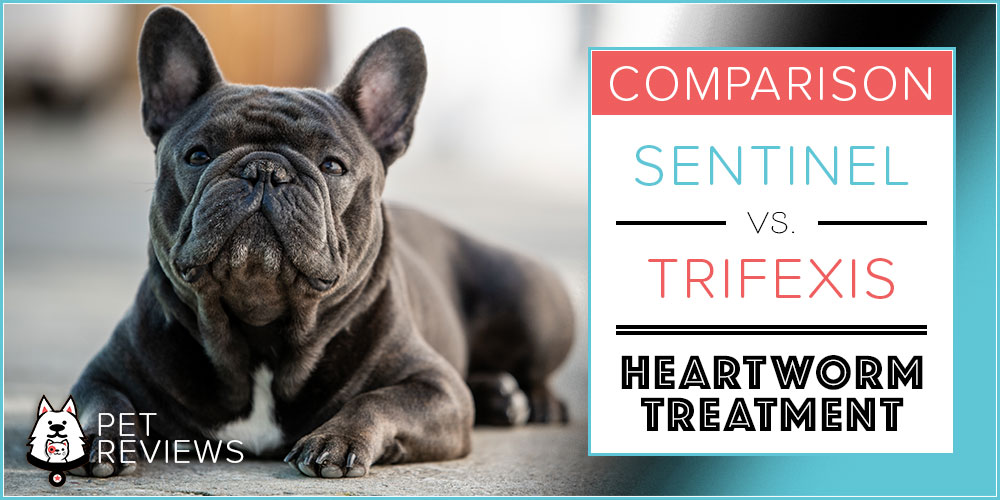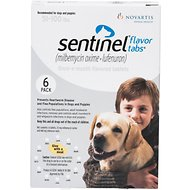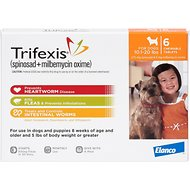Sentinel vs. Trifexis for Dogs: Our 2024 Guide to Which One Is Better
Quick Guide
- Key Differences Between Sentinel and Trifexis
- What Is Better for Dogs: Sentinel for Trifexis?
- Conclusion — Both Products Are Generally Safe
- 5 Key Features of Sentinel
- 5 Key Features of Trifexis
- Our 2024 Comparison of Trifexis and Sentinel
- Price Differences of Sentinel and Trifexis: Winner — Sentinel
- Availability: Winner — Tie Between Sentinel and Trifexis
- For Flea Treatment Which One Is Better: Sentinel or Trifexis?
- For Tick Treatment Which One Is Better: Sentinel or Trifexis?
- Ease of Use: Winner — Sentinel
- Overall Winner Between Sentinel and Trifexis — Our Pick Has to Be Sentinel!
- Top 4 Frequently Asked Questions
- Look Out For the Key Signs of Heartworm Disease
- Conclusion
Some of the most dangerous threats are the invisible ones. Before you even have a chance to recognize the signs, internal parasites can begin wreaking havoc on your dog’s system.
The most pervasive of these parasites is heartworm, which your dog can contract simply from a mosquito bite. Infected dogs may have a cough, appear tired after minimal exertion, and trouble breathing. If the infestation becomes serious enough, surgery will be required to remove the worms, and even then the dog’s life may not be saved.
Because this is such a serious threat, it is a good idea to regularly give your dog a medication that prevents heartworms and other parasites. Two commonly prescribed treatments are Sentinel and Trifexis, and while they are alike in the fact that they both treat heartworms, they bear many differences in areas like active ingredients and additional treatment abilities.
Key Differences Between Sentinel and Trifexis
The basic aims of Sentinel and Trifexis are quite similar, as are their methods of achieving those goals. Both medications are once-monthly chewable tablet treatments that will prevent your dog from contracting heartworm disease, as well as other common parasites like roundworm, hookworm, and whipworm. Neither of these treatments can cure adult heartworms, and they use the same active ingredient (Milbemycin Oxime) as the main vehicle to prevent your dog from picking up heartworm disease.
Though there are plenty of similarities between Sentinel and Trifexis, they have quite a few differences as well. We will discuss some of the most important ones here to help give you a better idea of where the biggest inconsistencies between these two treatments lie.
- Flea treatment — While both of these medications treat certain aspects of flea infestation, they do so by targeting different points of the flea life cycle. Sentinel kills flea eggs and larvae, preventing them from hatching or developing. Trifexis does just the opposite, killing adult fleas but not their eggs or larvae. Their approaches target opposite ends of the life cycle. It is worth pointing out that flea eggs and larvae are generally considered more difficult to kill than adult fleas.
- Speed of action — These two products are both preventative treatments for heartworm and they share an active ingredient that achieves this aim. Therefore, the speed of action difference lies in their flea treatment. Sentinel should begin killing flea eggs and larvae immediately, while Trifexis will take slightly longer to start killing adult fleas at around half an hour.
- Active ingredient — As mentioned above, these medications share one active ingredient (Milbemycin Oxime) in common. From there, they diverge. The other active ingredient in Sentinel is Lufenuron, which is a pest growth inhibitor that works to kill flea eggs and larvae.
The second active ingredient in Trifexis is Spinosad, which kills fleas at the adult stage. Spinosad can cause some dogs to experience a bit of itching and irritation of the skin for the first few hours after ingestion. This should not present a major issue, just be aware that your dog may experience some discomfort for a few hours after taking the medication should you choose Trifexis. - Safe age for administration — Sentinel is safe for dogs who are at least 4 weeks old and weigh at least 2 pounds. This means dogs can begin heartworm and other parasite prevention very early in their lives with Sentinel. It also means that very small dogs can safely take Sentinel. Trifexis is safe for dogs who are at least 8 weeks old and weigh a minimum of 5 pounds. While not quite as early as is possible with Sentinel, Trifexis still allows for preventative measures to be taken with young dogs. Both of these products are safe for very small and very large dogs alike.
- Tapeworm treatment — Of these two products, Sentinel is the only one that can help protect your dog from this common parasite, as well as all of the others that these both protect offer protection from. Tapeworm can play a large role in dogs experiencing malnutrition, so if you are concerned about your dog losing weight and don’t want to take any chances on your dog contracting this type of parasite, Sentinel is a great option.
Those are the main differences between these two popular prescriptions, but which one is better for your dog? We’ll discuss the safety of each of these treatments, and then outline some of their key attributes.
What Is Better for Dogs: Sentinel for Trifexis?
Both of these medications exhibit very low toxicity for dogs in the proper dosage. Milbemycin Oxime, Lufenuron, and Spinosad are all relatively safe for most dogs when kept within the recommended range.
However, as is the case with most prescription medications, there are possible side effects to stay aware of associated with each of these products, and many of those potential reactions overlap to a certain extent.
It is first important to note that Milbemycin Oxime (the active ingredient primarily responsible for heartworm prevention in Sentinel and Trifexis alike) is not safe for Collies or some other herding dogs, as these breeds have shown an intolerance for this drug and will likely exhibit some unsavory side effects even if only given a safe dose.
Lufernuron can sometimes be an irritant for some dogs’ stomachs, so pay attention to your dog’s behavior after they ingest the medication. This is also one of the reasons that it is suggested that dogs take Sentinel with food.
Potential reactions to Milbemycin Oxime and Lufernuron include:
- Diarrhea
- Drooling
- Loss of appetite/Lethargy
- Vomiting
- Seizures
If these side effects look familiar, it’s because most dog medications warn of the same possibilities. It is important to note that none of these reactions are standard in a healthy dog given the appropriate dose of Sentinel.
Since these two products share one active ingredient in common, it bears repeating that Trifexis is also not safe for Collies or other herding breeds with a documented intolerance to Milbemycin Oxime. Therefore, many of the potential side effects of Trifexis will overlap with those of Sentinel.
The other active ingredient in Trifexis, Spinosad, comes with some potential side effects of its own. Combined, the two active ingredients in Trifexis may cause:
- Itching
- Loss of appetite
- Diarrhea
- Lethargy
- Redness on ears and/or skin
No medication is wholly without side effects, so it is important to always weigh your dog’s current physical state against the side effects it may endure with any new treatment, and discuss concerns with a professional.
Conclusion — Both Products Are Generally Safe
Outside of the areas warned about, neither Sentinel or Trifexis should pose a serious bodily threat to your dog. Take note of the specific side effects listed; if your dog already experiences some of the issues that can be caused by one of the medications, avoid that treatment as it may exacerbate an existing condition.
For example, if your dog has a history of seizures, Sentinel may not be the best choice for heartworm prevention. Likewise, if your dog has a skin condition, Trifexis will probably not serve your pup as the best option. While these are things to consider, they do not certainly mean your dog should not take the medication. Your vet is the best resource for making those decisions, but do not hesitate to bring up your concerns with them.
Basically, if your dog is mostly healthy overall and is not a herding breed, either of these drugs should be safe to prevent heartworm diseases (as well as other parasite issues). There are no specific concerns that you need to stay aware of beyond those two considerations.
5 Key Features of Sentinel
Now that we have taken the time to outline the differences in these products and discussed their safety considerations, let’s take this opportunity to discuss the key features of each individual treatment, starting with Sentinel.
- Treats many additional internal parasites including tapeworm — The combination of Sentinel’s two active ingredients effectively prevents heartworm disease, as well as roundworm, hookworm, whipworm, and tapeworm. Each of these parasites poses its own threats, though heartworm is obviously the most pervasive and dangerous.
- Immediately begins killing fleas in the egg and larvae stage — Sentinel works to prevent flea infestation at the early life cycle stages. This means that if your dog is currently infested, Sentinel will not kill the adult fleas, but it will prevent the infestation from continuing by killing their eggs and larvae. Once the adult fleas die of old age, the infestation will end.
- Safe for puppies at 4 weeks old — This treatment is safe for very young puppies and very small dogs. As early as 4 weeks and at as little as 2 pounds, Sentinel can be administered to dogs for heartworm prevention.
- Administered once a month with food — Sentinel is disguised as a small, beef-flavored treat. To avoid discomfort for your dog, it should be given alongside food. The medication will continue working for 30 days after ingestion, so it must be administered every month for long term effectiveness.
- Available in 4 strengths — This medication can be purchased for four different size ranges of dogs: under 10 pounds, 11-25 pounds, 25-50 pounds, and 50-100 pounds. If your dog weighs more than 100 pounds it can still take Sentinel, but you should discuss the dosage variations with your vet.
5 Key Features of Trifexis
Again, since they share an active ingredient, some of the main characteristics of these two medications are bound to overlap in some areas just as they diverge in others. Here are 5 of the most important attributes of Trifexis.
- Begins killing adult fleas in 30 minutes — Trifexis works at flea prevention by killing fleas at the adult stage. This means that if your dog is currently infested, the flea life cycle will not be ended by Trifexis. However, after Trifexis is ingested, no adult fleas should live long enough on your dog to have the chance to lay eggs.
- Kills additional parasitic worms — Along with heartworm, Trifexis effectively protects against roundworm, hookworm, and whipworm. Trifexis targets parasitic worms in their larval stages, so they never develop into a serious concern.
- Safe for puppies at 8 weeks old — At just 8 weeks old and weighing only 5 pounds, puppies can safely ingest Trifexis. This means that about the time a puppy is ready to leave its mother it can begin preventative treatment with this medication.
- Administered once a month with food — For best results, Trifexis recommends that its chewable tablets are given alongside food. Getting your dog to take them should not be an issue, as they are also designed to taste like a treat.
- Available in 5 strengths — This medication should work for your dog regardless of size. It is available in 5 different ranges: 5-10 pounds, 10.1-20 pounds, 20.1-40 pounds, 40.1-60 pounds, and 60.1-120 pounds. Your dog can still take Trifexis if it weighs more than 120 pounds, you will just need to combine the appropriate doses.
Now we will compare Sentinel vs. Trifexis even further in categories like price, pest prevention, and ease of use, then we will select the overall winner between the two!
Our 2024 Comparison of Trifexis and Sentinel
Price Differences of Sentinel and Trifexis: Winner — Sentinel
This category is not exactly a close call—Sentinel is more cost-effective than Trifexis by quite a large margin. In fact, you can get a 6 treatment pack of Sentinel for around half the price of a 6 treatment pack of Trifexis in the same size category.
If you are mainly concerned about choosing an effective worm parasite prevention medicine and are less worried about killing off adult fleas, Sentinel is an obvious choice as it is much more affordable, and will even help with a different stage of flea prevention.
Availability: Winner — Tie Between Sentinel and Trifexis
Both of these products are widely available on different websites, and although Trifexis is much more expensive as mentioned above (meaning that it may be less attainable than Sentinel for some) this has no bearing on the actual availability.
Sentinel and Trifexis are both prescription medications, so you can still order them online but will need your prescription at the ready to input the necessary information before purchasing. Since both medications are widely available, be sure to comparison shop before choosing where to buy. In the end, your vet’s office may even be able to give you the best deal.
For Flea Treatment Which One Is Better: Sentinel or Trifexis?
Generally speaking, we would have to go with Sentinel in this category, but this is somewhat variable based on whether or not your dog is already infested with fleas, and whether or not you are comfortable taking other extermination measures. This is another point of contention to discuss with your vet if you are unsure where you and your dog stand.
Sentinel kills flea eggs and larvae, unlike Trifexis which kills adult fleas. We feel that Sentinel is overall better at treating fleas since adult fleas can be killed in a number of other simple ways (like a flea bath, for example) but flea eggs and larvae cannot. If your dog is currently infested with fleas, Sentinel will ensure that no additional fleas hatch and you can take some simple additional steps to kill the current brood of adults.
For Tick Treatment Which One Is Better: Sentinel or Trifexis?
Neither of these treatments is approved for or effective at treating ticks. Often medications that treat fleas also treat ticks, so it is an easy habit to lump the two pests together. In this case, though, you should not rely on Sentinel or Trifexis to eliminate a current tick problem or offer any sort of prevention.
There are plenty of great tick preventative medications on the market, but you may have to regularly give your dog an additional med. Unfortunately, neither Sentinel or Trifexis can offer a one-stop shop option for total pest and parasite prevention.
Ease of Use: Winner — Sentinel
In all honesty, Sentinel and Trifexis are practically tied in this category as well, as they are both chewable tablets meant to be given once a month with food. Additionally, they both contain a beef flavor meant to encourage your dog to take the medicine.
The only reason we have given Sentinel a slight edge here is that the tablet itself looks more like a treat, whereas Trifexis looks more like a pill. If your dog has had a negative experience taking medications in the past, they may be once bitten, twice shy about anything that resembles a pill. Again, the process of administering these two medications is identical, we simply feel that Sentinel will have an easier time masquerading as a treat for discerning pups.
Overall Winner Between Sentinel and Trifexis — Our Pick Has to Be Sentinel!
In terms of serving their main purpose (preventing heartworm disease), Sentinel and Trifexis perform practically identically. Their possible side effects are generally intertwined by their common active ingredient, and they are both a once monthly chewable tablet.
These treatments bear many similarities to one another, but where they do diverge, Sentinel tends to come out ahead: it is less expensive, safe for younger and smaller dogs, treats a more difficult stage of the flea life cycle, and also protects against an additional kind of digestive parasite.
Being that they are so alike, Trifexis is obviously a great option as well, and may, in fact, be the right option for your dog. Be sure to discuss the right choice with your vet, but bear in mind what you have learned from this guide when you do.
Top 4 Frequently Asked Questions
We have taken the time to provide answers to some of the more common FAQs regarding Sentinel vs. Trifexis here. If you have additional questions that we do not address, be sure to use your veterinarian as a resource.
- What is the generic for Trifexis? There is no exact generic equivalent for Trifexis, but Sentinel is chemically very close and usually comes at a fraction of the price. If your vet has prescribed Trifexis, consider asking them whether Sentinel might also work well for your dog. Although it won’t kill adult fleas (only eggs and larvae) it will perform every other of Trifexis’ effects in the same way.
- Should I give my dog Sentinel? Yes, as long as your vet prescribed Sentinel there is nothing to worry about. Though the active ingredient in Sentinel is not safe for Collies or some other herding breeds, a vet will know about this intolerance, so you can rest assured that Sentinel is not unsafe for your pup.
- Is Trifexis better than Sentinel? Not necessarily. As you can see above, we actually ranked Sentinel over Trifexis for a number of reasons, but Trifexis could actually be the right choice for your specific situation. It is important to note that Sentinel is significantly less expensive than Trifexis, so it may be a good alternative to explore.
- Is Sentinel good for dogs? Yes—as much as any medication can be. There are some possible side effects, and certain breeds have an intolerance for one of the active ingredients in Sentinel. However, these side effects aren’t common, and the benefit of heartworm disease prevention outweighs the possibility greatly.
Look Out For the Key Signs of Heartworm Disease
If left untreated, heartworm disease can be fatal. Some of the signs include labored breathing, coughing, and general lethargy or showing fatigue after only minimal or moderate exertion.
Once it is contracted, heartworm disease can be difficult to treat; if it is far enough advanced, it may even require surgery. This is the reason that it is so crucial you prevent the disease from developing in the first place.
Since there is no way to ensure that your dog will never be bitten by a mosquito that infects it, the only sure method of prevention is medication like the ones we have discussed here.
Conclusion
We know that sifting through information about medications for your pet can be confusing and tiresome; that’s why we assembled this guide to assist concerned dog parents to make the most informed choice possible about which heartworm preventative is right for your pup.
Though we ultimately feel that Sentinel is the better option when putting head to head with Trifexis, we know that each situation is different. We encourage you to take the knowledge you have gained in this guide with you to your vet’s office and have a discussion with them about your options.
Heartworm and other internal parasites are invisible killers. Don’t wait until it’s already too late to begin treating heartworm disease, utilize this guide to help you choose the best preventative measure to guard your dog.












